‘A Place for Us, By Us’: San Francisco’s Disability Cultural Center Breaks New Ground
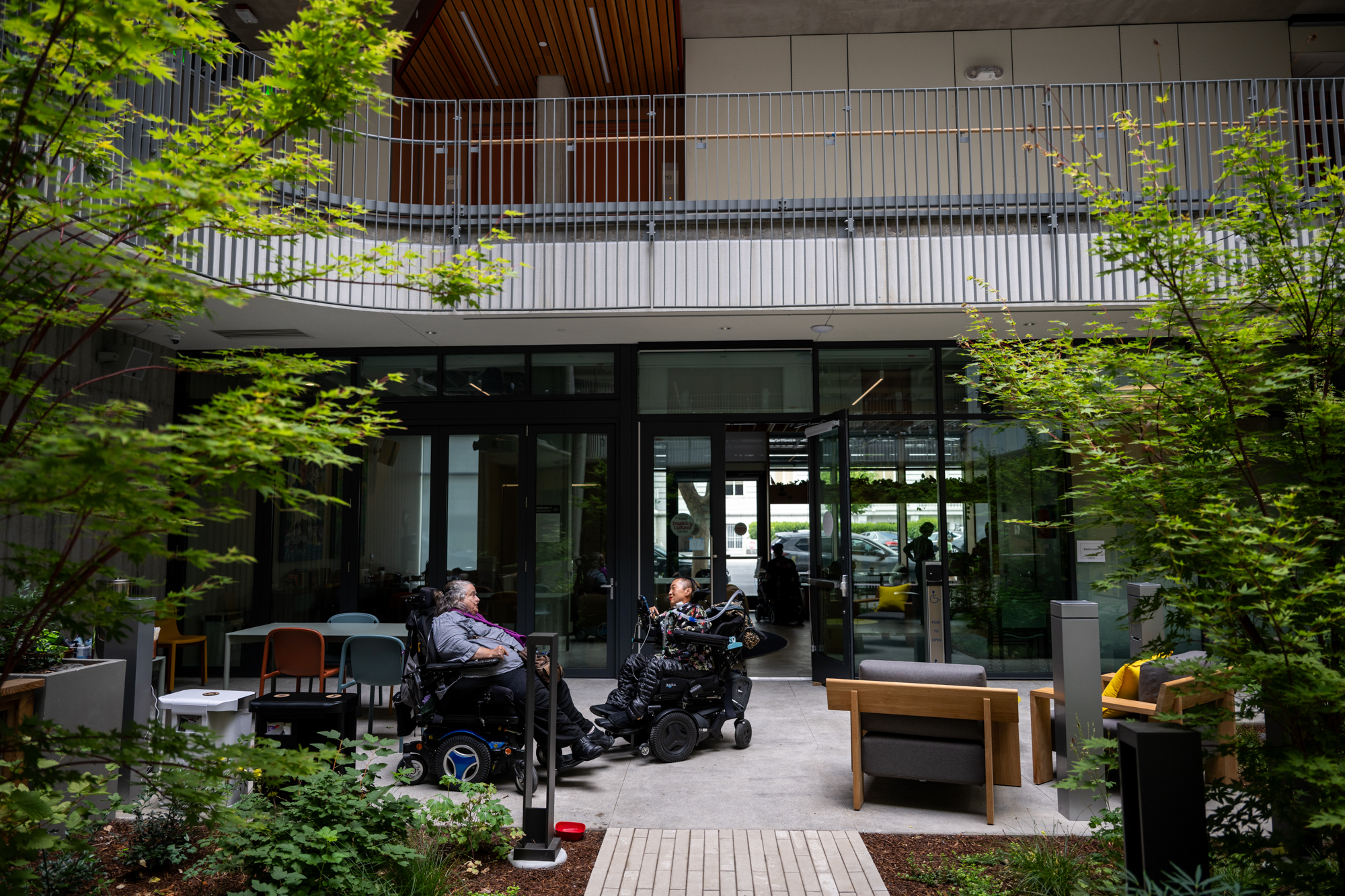
Debbie Kaplan (left), deputy director at the Office on Disability and Accessibility, speaks with Alice Wong, a disability rights activist and founder of the Disability Visibility Project, at the Disability Cultural Center on Aug. 13, 2025. (Beth LaBerge/KQED)
Nearly five decades ago, frustration over the government’s lack of urgency to make public buildings more accessible reached a flashpoint. It was April 1977, and more than 100 disabled protesters staged a nearly month-long sit-in at a federal building in San Francisco’s United Nations Plaza.
After 26 days, and with support from groups like the Black Panthers and allies including then-Mayor George Moscone, the activists successfully convinced the country’s secretary of health, education and welfare to implement the long-delayed Section 504 of the Rehabilitation Act of 1973. The law prohibits discrimination based on disability in programs that receive federal financial aid.
The protest became recognized as the 504 Sit-in, and paved the way for the Americans with Disabilities Act more than a decade later. This summer, the city moved that legacy forward, opening the nation’s first Disability Cultural Center, located directly across from San Francisco City Hall.
“It took a while to start to see things change, but the ADA ushered in new building standards. New buildings had to be accessible in very specific ways,” said Deborah Kaplan, deputy director at San Francisco’s Office on Disability and Accessibility. The 504 Sit-in protests sprouted up in cities across the country in 1977, and Kaplan participated in Washington D.C.
“All of a sudden, I could go places and not have to scope it out in advance and worry that there was no way in or worry that I couldn’t use the bathroom for new places,” Kaplan said of progress that has followed in the decades since.
Activists like Kaplan have pushed San Francisco — and the nation — to raise accessibility standards for decades. Those working with the Disability Cultural Center now see the site as another victory in the disability justice movement in San Francisco and beyond.
“Having this space of belonging, celebrating disabled joy and having the disability community seen right across from City Hall, it’s just so incredibly unique and powerful,” said Eli Gelardin, director of the city’s Office on Disability and Accessibility. “We have a place to gather and build and further share with the broader community.”
After several years of planning and delays from the COVID-19 pandemic, the center first began hosting events online in 2024. As the online community grew, organizers worked with the city to prepare for the center’s physical space opening in summer 2025.

Visitors sit at an outdoor table at the Disability Cultural Center in San Francisco on July 31, 2025, during a plant potting activity at the center. (Beth LaBerge/KQED)
Today, the center is bustling.
With walls lined with paintings by disabled artists and furnished with cafe-style seating and cushioned chairs that can move about, the space offers a flexible gathering space alongside an airy courtyard. Nestled in cubbies along the inner walls are buckets filled with toys, games and medical safety supplies.
“We did a dance class yesterday out on the patio that was utilizing the space in new ways,” said Emily Beitiks, one of the center’s three co-directors. “Everything is meant to have multipurpose use so that it maximizes our use of the space.”
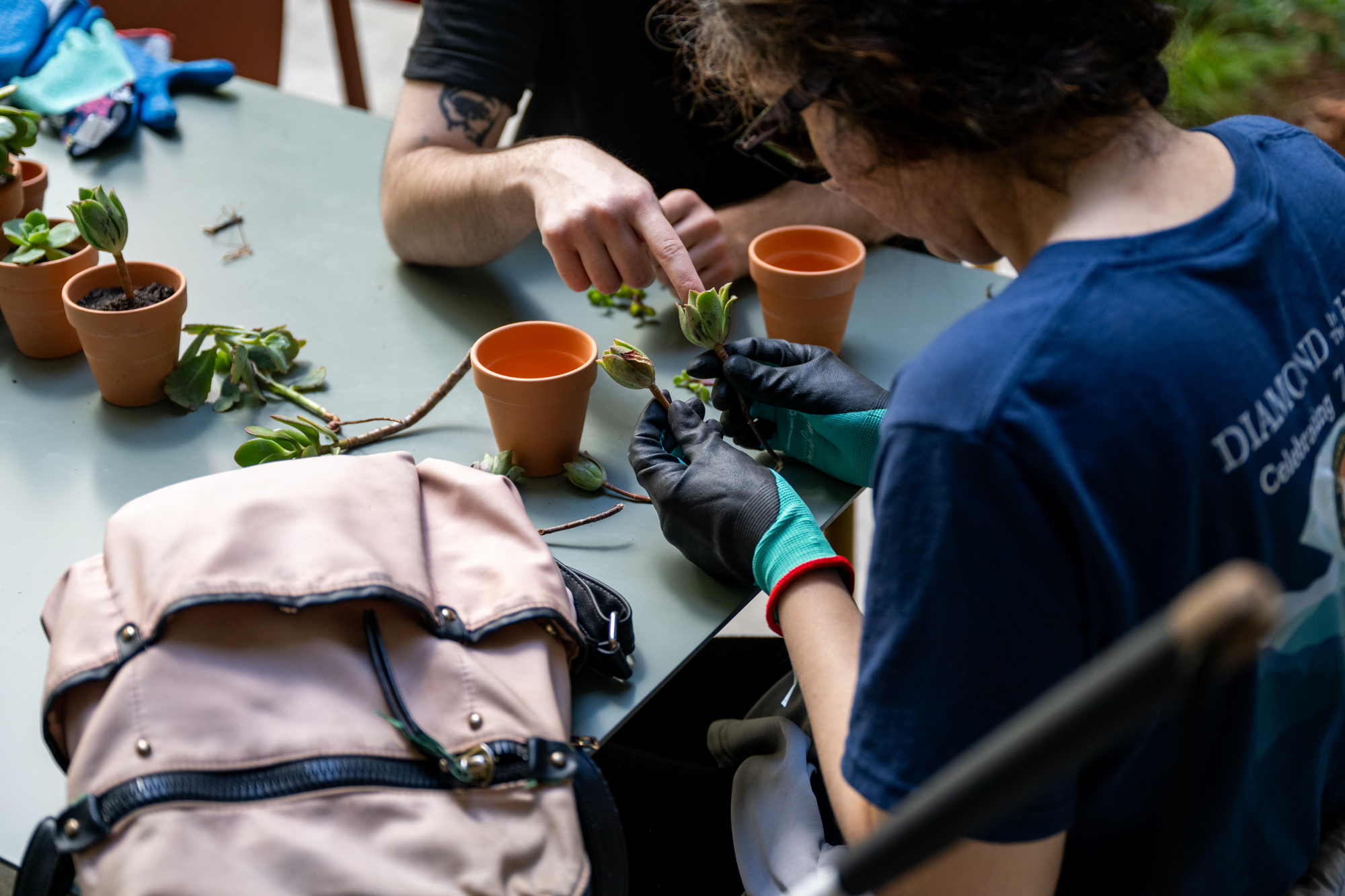
Volunteer Valentin Davis (left) sits with Masooma at the Disability Cultural Center in San Francisco on July 31, 2025, during a plant potting activity at the center. (Beth LaBerge/KQED)
Since opening in-person in July, the site has hosted a zine-making class, plant potting workshop, a small film festival and several other events.
Community members are keeping the calendar full with upcoming events like a job search session and peer support groups for different disabilities and chronic illnesses.
The center is publicly funded and contracting with nonprofit Haven of Hope for the next four years.
But the work of making public spaces more accessible is far from over. One frustrating example Kaplan has on her mind is a central elevator at Hallidie Plaza, next to the Powell Street BART station, that has not worked in more than 20 years.
For residents like Alice Wong, a disabled writer and activist, the broken elevator is both a symbol of ongoing struggle and a literal barrier to moving through her own neighborhood.
“If the Hallidie Plaza elevator was working, it would be the one closest to my home, but instead I have to go an entire block, which is pretty long, to the one on 4th Street,” said Wong, who lives in the South of Market neighborhood. “I look forward to an accessible Hallidie Plaza entry.”
Wong moved to San Francisco in 1997 to attend graduate school at UCSF. She was familiar with the city’s history of disability activism and chose the city in part because she wanted to meet more wheelchair users like herself, who understand their disability as a part of their political identity.
Despite moving to the city seven years after the ADA passed, Wong found many barriers to getting around her new campus and city.
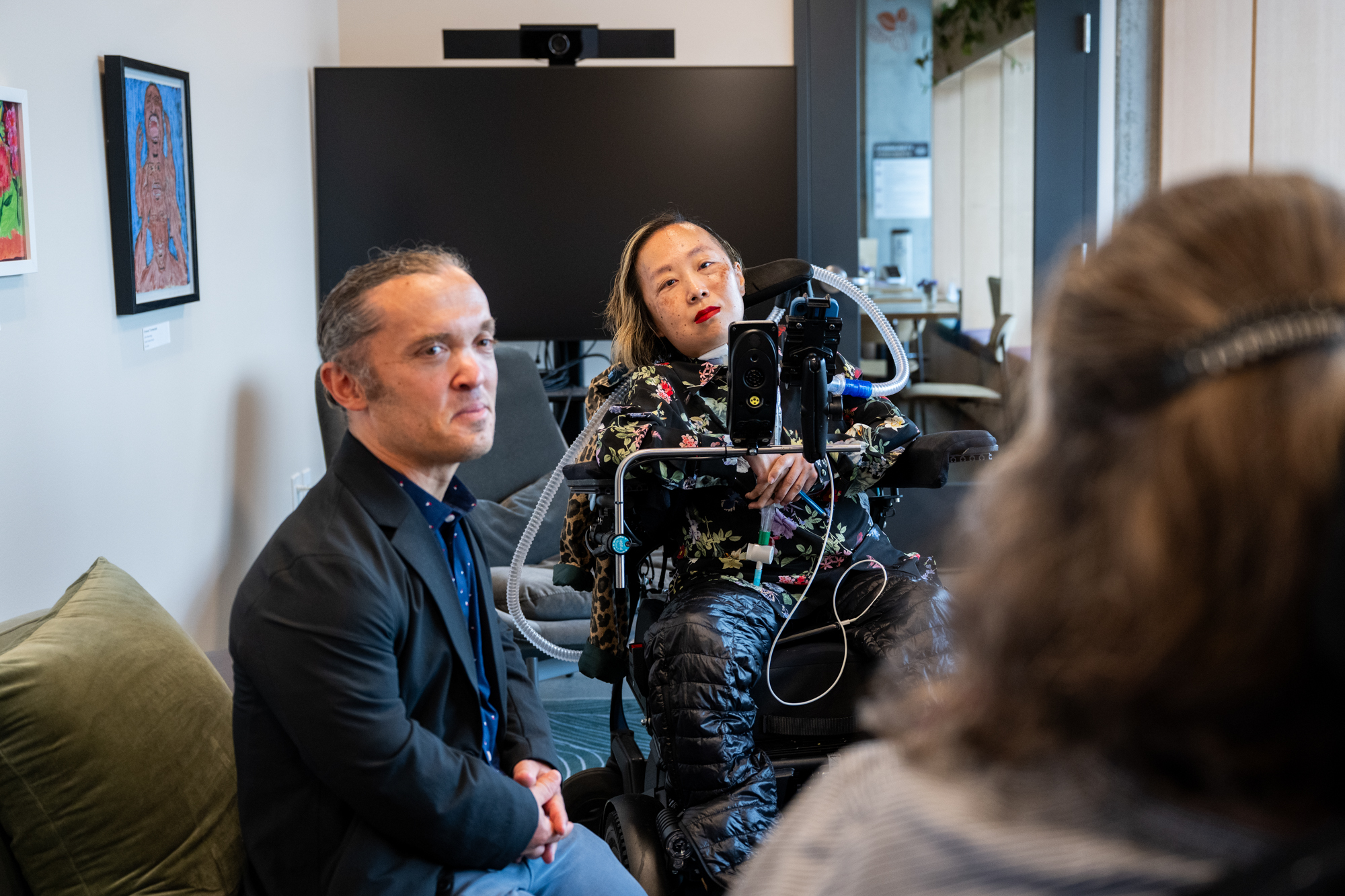
(From left) Eli Gelardin, director of the Office on Disability and Accessibility, speaks with Alice Wong, a disability rights activist, and Debbie Kaplan, deputy Director of the Office of Disability and Accessibility, at the Disability Cultural Center on Aug. 13, 2025.. (Beth LaBerge/KQED)
“None of their student housing was accessible, so they had to renovate the basement of a faculty house so I could live there,” Wong said. “Changes by major institutions were very gradual.”
At the Disability Cultural Center, accessibility was not an afterthought tacked on to comply with regulations, but rather part of the facility’s design from the start.
“The Disability Cultural Center offers a place for us, by us, that isn’t a service or medical provider,” said Wong, who leads the Disability Visibility Project. “It shouldn’t be radical, but it is — to have a space centered on disability culture where it celebrates who we are that’s not centered on any one diagnosis or on fixing us.”
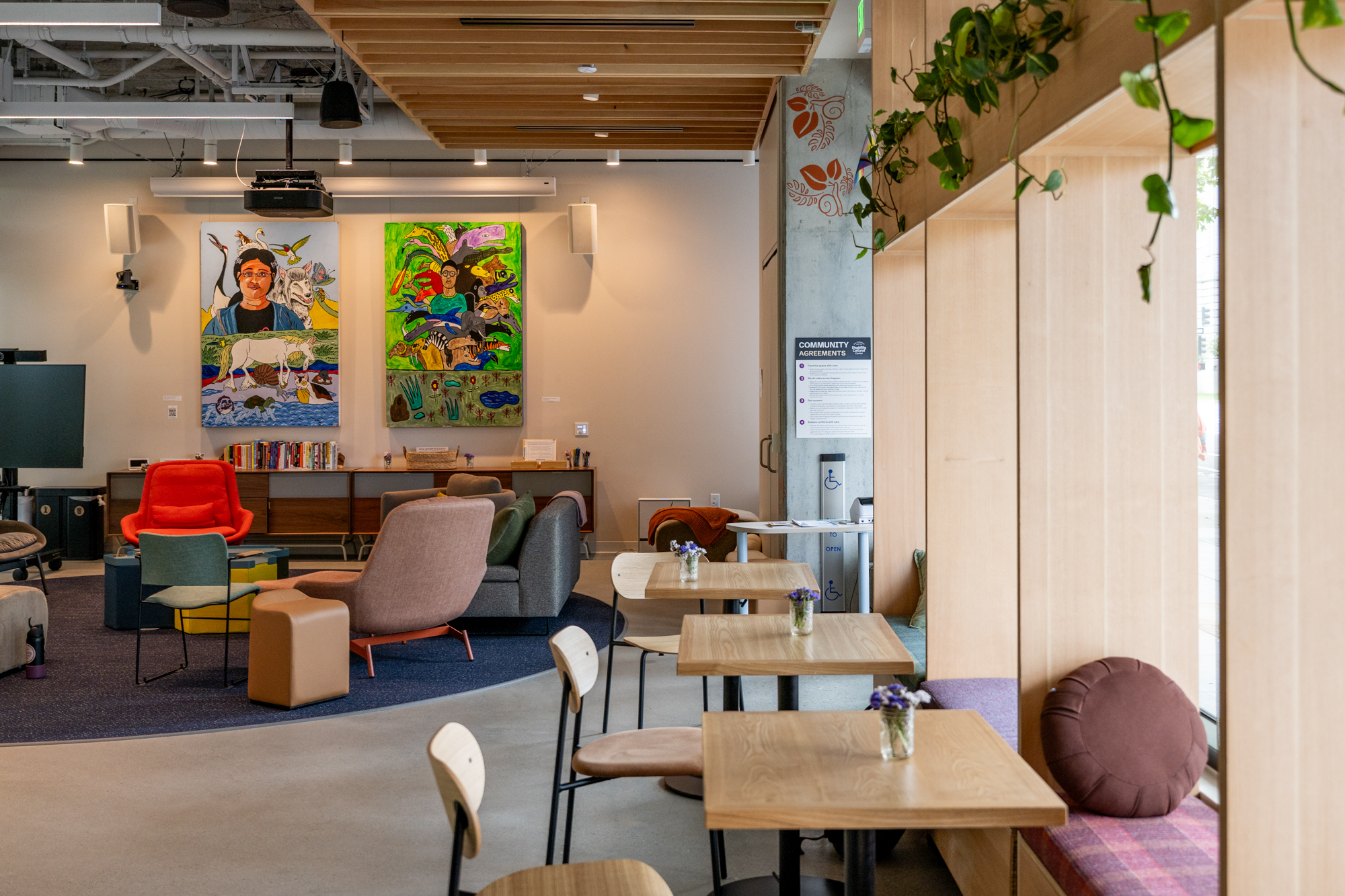
The newly opened Disability Cultural Center in San Francisco on July 25, 2025. The cultural space is dedicated to celebrating disability culture through accessible community events. (Beth LaBerge/KQED)
Including beautiful, accessible housing was another central part of the design to meet the needs of the disabled community.
The center is housed on the ground floor of The Kelsey Civic Center, a 112-unit mixed-income housing development where 25% of units are reserved for people with disabilities.
“Many homes have a flight of stairs up to the entrance, such as the charming Victorians San Francisco is famous for. And a lot of apartment buildings that aren’t high-rises don’t have elevators. That makes it difficult to age in place,” Wong said. “Livability and affordability should be part of the same goal when it comes to new housing in San Francisco.”
The center has attracted visitors like San Francisco resident Sophie Mai. She heard about it while visiting a wellness clinic in the city, and dropped in on a recent Friday afternoon to check it out.
“Representation is important, also for invisible disabilities, and this is a beautiful space,” Mai said while sitting on one of the lounge chairs in the center’s living room. “I’m looking forward to spending more time here.”
Today’s political climate and cuts to Medi-Cal, food stamps and other social safety net programs makes the need for community even greater, according to Wong.
“We need the DCC more than ever. Disabled people are not okay,” Wong said. “We are scared and enraged, and this center will be a place of connection where we can build power and feel less alone.”
Unlike many of the city’s other cultural centers, which often focus on heritage and ethnic identity, the Disability Cultural Center aims to bridge race, gender and other identities.
It honors the roots of the disability rights movement, including the support from groups like the Brick Hut Cafe, a queer-run cooperative in Berkeley, as well as Glide Memorial Church and the Black Panthers, who helped feed protesters at the 504 Sit-in in San Francisco.
“Disability justice was developed by people of color who felt that the previous movements did not address their lived realities,” Wong said, pointing to leaders like Brad Lomax, a disabled member of the Black Panther Party, who helped organize the Bay Area protest and later went on to start the East Oakland Center for Independent Living.
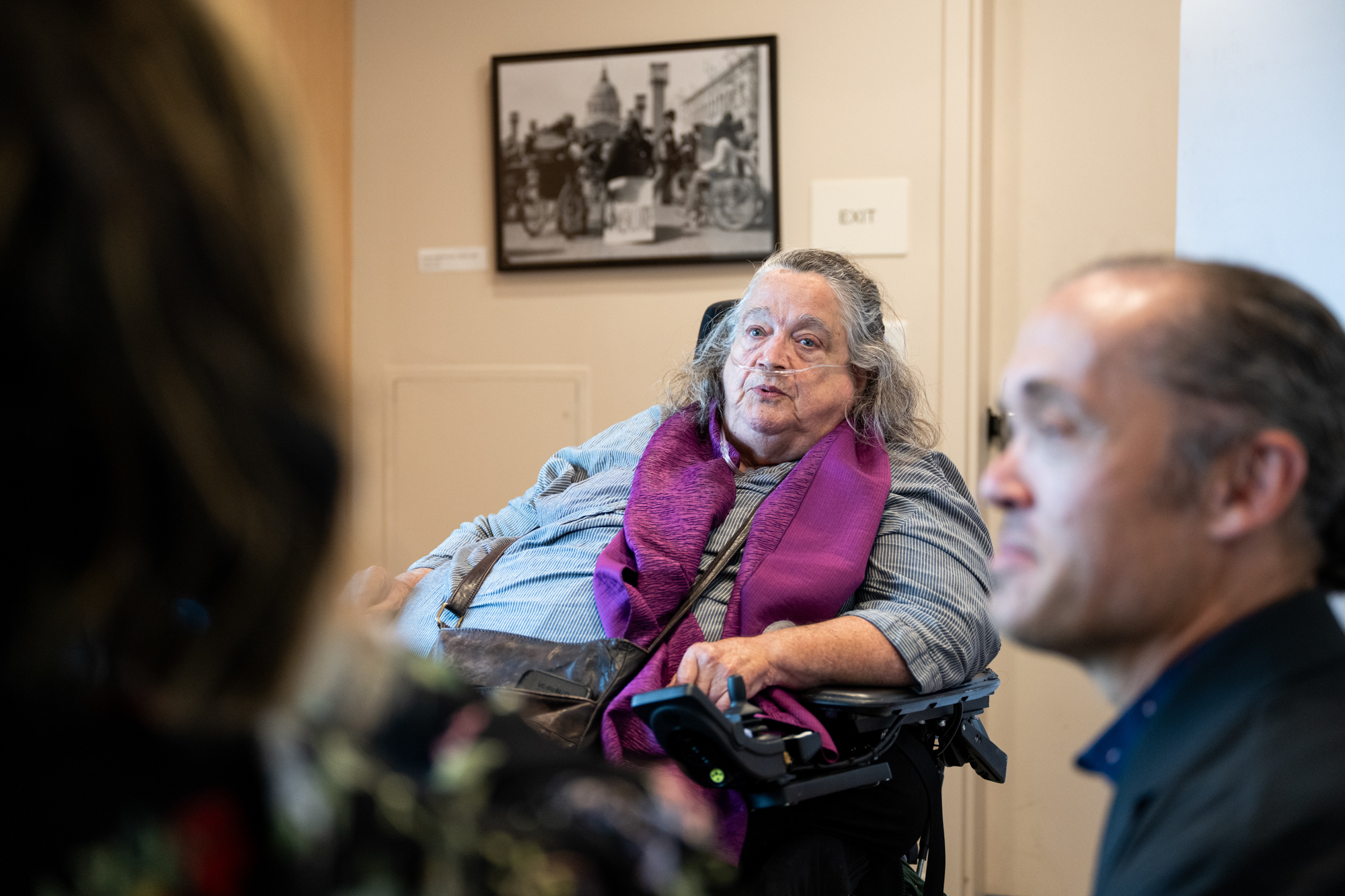
Debbie Kaplan (center) speaks with Alice Wong (left) disability rights activist and Eli Gelardin at the Disability Cultural Center on Aug. 13, 2025. (Beth LaBerge/KQED)
“Movements are successful if they remember the lessons of their elders and appreciate the historical and political context in which they occurred,” Wong said. “One principle of disability justice is a commitment to cross-movement organizing.”
The model is already drawing interest from other cities. People in places such as Detroit have reached out asking about what it might take to bring a Disability Cultural Center to their hometown, according to co-director Beitiks.
“When countries are upgrading their cities or new cities are getting developed, they’re all accessible, because that’s how a country shows the rest of the world how up to date it is and what a great place it is,” Kaplan said. “That’s remarkable.”